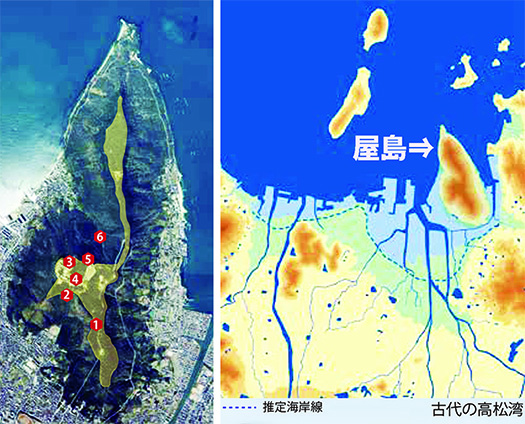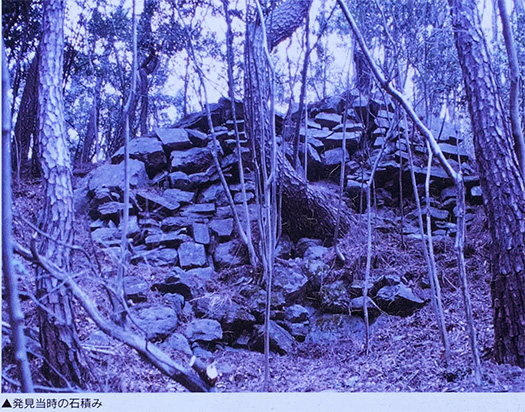


日本という国は地政学的に東アジアの一員として
ながく歴史を紡いできたけれど、常に中国との関係に悩まされてきた。
日本側の社会発展も中国との交流を通じて主に計られてきたし
たびたび戦争危機が訪れてきて社会変動の起因になってもきた。
明治維新以降はいち早く欧米世界と交流を始めて社会発展した日本に対して
中国は伝統的外交方針としての朝貢外交で「自己中」の殻に閉じこもった。
現代の「戦狼外交」ぶりを見るとそこからあまり本質は変わっていない。
朝貢意識が抜けないままとにかく国内を統治することがギリギリで
世界中から徹底的に嫌われることにまで意識が回っていないと思える。
そういう中国国家との緊張関係が歴史ではじめて戦争局面まで高まったのが
白村江敗戦以降の時期で、朝鮮半島での利権・百済との関係を保守するために
唐との関係が最悪の時期を迎えた。
白村江で百済が完全に消滅しその王族・遺臣たちが日本に逃れてきた。
唐と新羅はその勝利の余勢を駆って日本を侵攻する危険性が高かった。
たぶん新羅は侵攻を主張しただろうけれど、
本国からは遠く隔たった日本への侵攻には唐がためらっていたのではないか。
結果としては日本と唐・新羅との戦後外交の進展で
「日本本土決戦」は避けられたのだけれど、
対中国の戦争準備は忌まわしい記憶として王権に語り継がれていたに違いない。
中国・朝鮮から日本を侵略するにはこの時代、瀬戸内海ルートが一般的。
大船団を組んで侵攻するには九州、瀬戸内海、ヤマト盆地と
順次攻略する必要性があったに違いない。
日本軍が百済救援に大船団を送れたのは現地で百済からの兵糧支援があったから。
それに対して唐・新羅が軍船団を派遣するには
九州などで略奪で兵糧を獲得する必要があっただろう。
この時代の王権の支配力、末端権力のグリップがどの程度だったか、
九州の現地ではたぶん唐・新羅に呼応する勢力もあったにちがいない。
中大兄皇子としては、あらゆる危機対応を考えざるを得なかった。
百済から逃避してきた軍人たちは対唐・新羅連合軍の戦術として
瀬戸内海ルート上にたくさんの防衛拠点を造作した。
屋島は瀬戸内海の中でも備讃瀬戸の東限に位置し畿内に抜ける海上ルート要所で、
特に唐・新羅の大船団を迎え撃つには非常に重要な場所だった。
屋島は地理的に淡路島直前の大きな「砦」と考えられたのだろう。
当時は陸から離れた島であり、戦争の攻撃手段としては
小型軍船で遠征軍の船舶を火矢で「火攻め」にするのがまず考えられる作戦。
防御面では島の9割方が急峻な崖で覆われている地形は稀有な防御力。
屋嶋城の山上城壁は全長7キロに渡ってめぐらしたが島のほとんどは断崖絶壁で、
人工的に崖面に城壁が築かれていたのはそのうちの約1割程度。
比較的に上陸しやすい地点を城壁、石積みして固めたことだろう。
こういう状況を見ると白村江からこの時期まで、
まさに東アジア「世界大戦」の様相。遺跡発掘復元によって日本史が
より鮮明になっていく可能性が高い。ひょっとすると戦国期並みの
大注目時代になって行くのではないかと思っています。
<写真類は高松市HPから>
English version⬇
[Yashima Castle, a base for intercepting military fleets from Tang, Shikoku, Yashima-3]
Japan is geopolitically a member of East Asia
Although he has spun history for a long time, he has always been troubled by his relationship with China.
Social development on the Japanese side has also been measured mainly through exchanges with China.
War crises have often come and have become the cause of social change.
For Japan, which has developed socially by starting exchanges with the Western world as soon as possible after the Meiji Restoration
China has been trapped in a “selfish” shell with tribute diplomacy as a traditional foreign policy.
Looking at the modern “Wolf Warrior Diplomacy”, the essence has not changed much from there.
Governance of the country is just barely possible without losing consciousness of tribute.
I don’t think I’m conscious of being completely disliked by people all over the world.
It was the first time in history that such a tense relationship with the Chinese state rose to the war phase.
To maintain the relationship with Baekje, the concession on the Korean Peninsula, after the defeat of Baekgang
The relationship with Tang has reached its worst time.
Baekje disappeared completely in Baekgang, and the royal family and vassals fled to Japan.
Tang and Silla were at high risk of invading Japan with the surplus of victory.
Maybe Silla insisted on the invasion,
Tang may have hesitated to invade Japan, which is far from his home country.
As a result, the progress of postwar diplomacy between Japan and Tang / Silla
Although the “mainland Japan decisive battle” was avoided,
The preparation for the war against China must have been handed down to the kingship as an abominable memory.
In this era, the Seto Inland Sea route is common for invading Japan from China and Korea.
To invade with a large fleet, Kyushu, the Seto Inland Sea, and the Yamato Basin
It must have been necessary to capture them one after another.
The Japanese troops sent a large fleet to rescue Baekje because of the local military support from Baekje.
On the other hand, how to dispatch a military fleet to Tang and Silla
It would have been necessary to obtain troops by looting in Kyushu and elsewhere.
What was the grip of the royal power and terminal power of this era?
There must have been some forces in Kyushu that responded to Tang and Silla.
As a middle-aged prince, I had no choice but to think about all kinds of crisis response.
Military personnel who have fled from Baekje are a tactic of the Allied Forces against Tang and Silla.
Many defense bases were built on the Seto Inland Sea route.
Yajima is located in the eastern limit of Bisan Seto in the Seto Inland Sea, and is a key point on the sea route that leads to Kinai.
In particular, it was a very important place to meet the large fleet of Tang and Silla.
Yajima may have been geographically thought of as a large “fort” just before Awaji Island.
At that time, it was an island away from the land, and as a means of attacking the war.
The first strategy that can be considered is to use a small warship to “fire attack” an expeditionary ship with a fire arrow.
In terms of defense, the terrain where 90% of the island is covered with steep cliffs is a rare defense.
The Yamagami castle wall of Yashima Castle stretched over a total length of 7 km, but most of the island was a precipitous cliff.
About 10% of the walls were artificially built on the cliff surface.
It must have been hardened by masonry on the walls at a point where it is relatively easy to land.
Looking at this situation, from Baekgang to this time,
It is exactly the aspect of East Asia’s “World War”. Japanese history is revealed by excavation and restoration of archaeological sites
It is likely to become clearer. Possibly the same as the Warring States period
I think it’s going to be a hot era.
Posted on 1月 23rd, 2022 by 三木 奎吾
Filed under: 日本社会・文化研究, 歴史探訪







コメントを投稿
「※誹謗中傷や、悪意のある書き込み、営利目的などのコメントを防ぐために、投稿された全てのコメントは一時的に保留されますのでご了承ください。」
You must be logged in to post a comment.